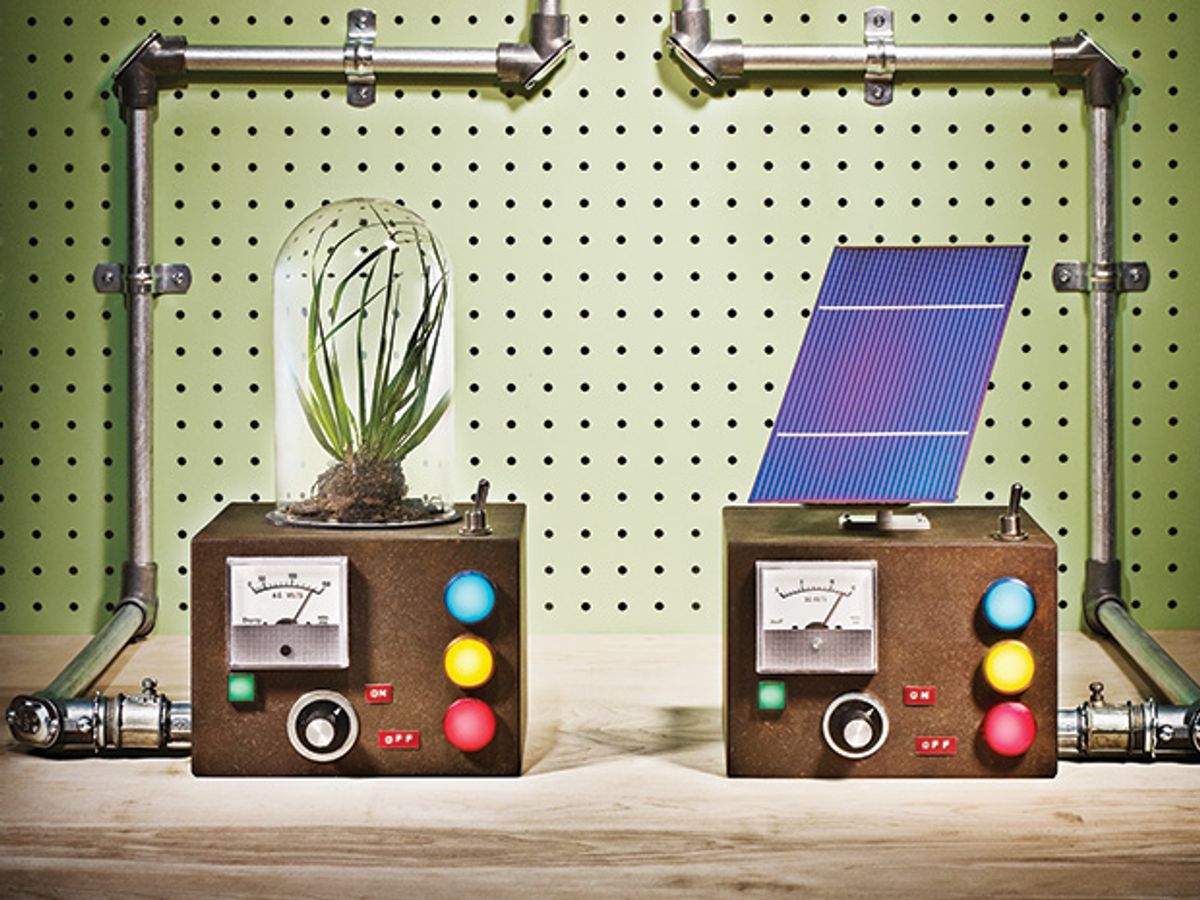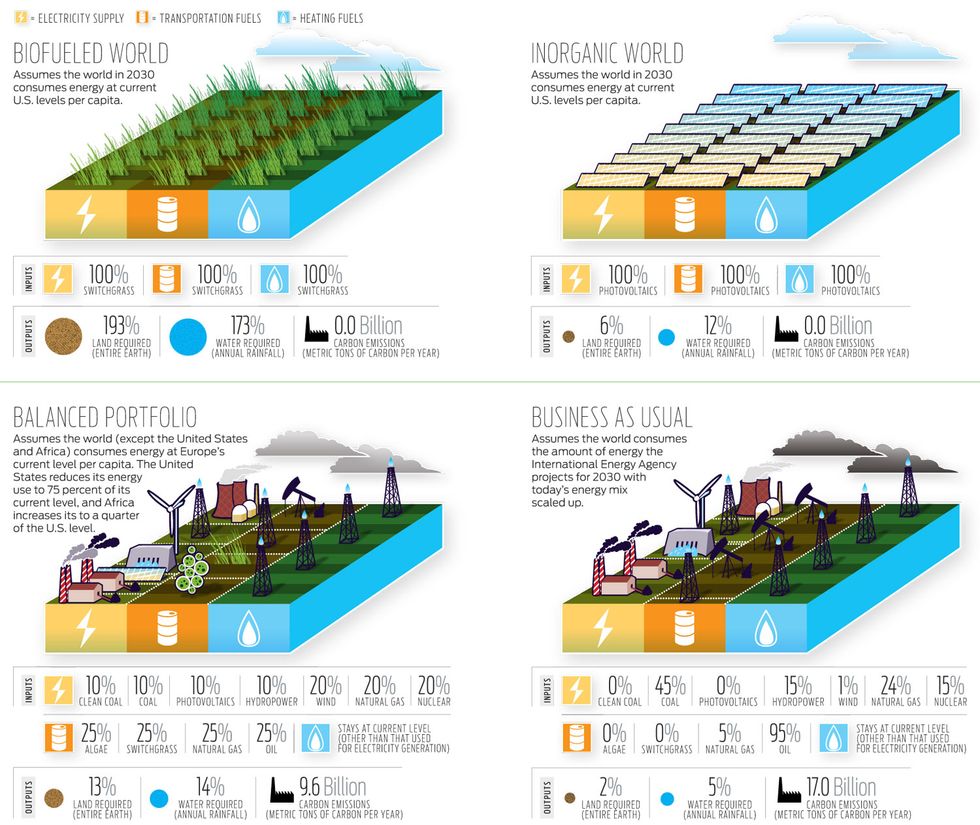Biofuels Aren’t Really Green
Cultivate inorganic energy sources instead of biofuels

Sustainable, green, renewable, organic—the words come up so often in energy and climate debates that they tend to sound as if they mean the same thing. But of course they don't. Nuclear reactors emit no carbon and are therefore in a sense green, but uranium is nonrenewable; hydropower is green and renewable but may not always be sustainable, because the ecological consequences can be bad and reservoirs are not limitless; coal is organic, but its carbon emissions make it the very opposite of green. All that is obvious enough. But even so, it may be jarring to hear—as we have found and will describe—that organic biofuels can't possibly fuel a growing world economy in a sustainable manner, whereas, in principle, inorganic fuels could.
That inorganic might beat organic contradicts fashionable prejudice, which like all fashion changes with the season. Take the case of the United States: First came the enthusiasm for corn ethanol, its extravagant subsidization, and a farm-industrial miniboom. Then, when corn's limits started to become better known and its costs more glaringly obvious, we started to hear about the promise of switchgrass, a native species of the North American prairie that promises high energy-conversion efficiencies. President George W. Bush first mentioned it in a 2006 speech to the nation. Before long, Al Gore was chiming in too, promising that with adequate government support for research, grass-based fuels could free us from the dual specters of energy shortage and runaway climate change.
In Germany rapeseed has been all the rage; in India, jatropha; and in Brazil, sugarcane ethanol. Yet the plain fact is that nobody really knows when or whether organic fuels will be competitive. Engineering breakthroughs, by their nature, are unpredictable—that's what makes them exciting. So to evaluate whether organic fuels could ever be in a position to power the world, we looked at them purely in terms of physical resource availability, assuming that the costs would eventually become competitive. We asked how much land and water would be needed to make the quantities of biofuel that a prosperous world would need. We also asked whether there were other sources of fuel and energy that might put less strain on resources while adding less greenhouse gas to the atmosphere.
To our own surprise, the model we constructed showed that there is simply not enough land and water to support a prosperous biofueled world. At the same time, it suggested that inorganic sources, such as photovoltaic cells, can in principle do the job.
Our simple model, developed at the school of electrical and computer engineering at Georgia Tech, is designed to evaluate alternative energy scenarios. It simulates the consumption of energy, land, water, and carbon both globally and on regional scales; it projects emissions of carbon and waste heat; and it takes all obvious interdependencies into account. It assumes that electricity and water can move throughout the world without loss, that all land and freshwater are available for human use, and that in 20 to 25 years all the countries of the world will have access to sufficient resources to live as well as the United States does today.
There isn’t enough water or land to sustain a prosperous world powered entirely by biofuels, but a similar world powered by solar energy is at least theoretically possible. Realistically, the future will have elements of both.
Click to enlarge the image
The last point deserves some emphasis. Many futuristic energy models, including some much more complicated and sophisticated than ours, constrain future economic development in the name of sustainability. On both moral grounds and as a matter of practical politics, we reject such constraints. There is no justifying a regime that would limit a large fraction of the world's population to a much lower level of prosperity than North Americans, Europeans, and Japanese now enjoy, nor would Brazilians, Chinese, or Indians agree to such an arrangement. Therefore, in evaluating the demands that the consumption of energy in whatever form would place on the earth, the water supply, and the atmosphere, we assumed that nobody in the world would be denied the aspiration of reaching the current U.S. level of consumption and prosperity just because available resources have been consumed by the wealthier and more developed nations. Some may quibble that our growth projections are ambitious, and so they are; our key assertion is that sufficient energy must be available to enable economic growth if the average world citizen is to live at current U.S. levels by 2030 or 2050.
Today most of the world's agricultural output is consumed by people and their livestock, and in the prosperous countries the vast majority of the grain goes to the livestock. But for simplicity's sake we have assumed that all the food in the world would come to our tables as grain or meat and that the output would be split into just two crops, summer corn and winter wheat. Further, we assumed that land taken from those crops to produce biofuels instead will all be used to produce just one crop, namely switchgrass, or to make room for one renewable but inorganic resource, namely photovoltaic (PV) electricity. In this way, we put the organic and inorganic futures into the starkest contrast.
Those choices, though obviously not realistic, struck us as reasonably conservative. Switchgrass seemed a fair compromise among biofuels; it has a good shot at near-term economic viability because it can provide more net energy for a given amount of carbon emissions than corn ethanol. In the longer run there may be more promise in futuristic biofuels made from sources such as bioengineered algae, but to become competitive they will require many scientific and technological advances.
Photovoltaic electricity, like switchgrass, presents challenges but also seems likely to achieve economic competitiveness in the foreseeable future without requiring extraordinary scientific breakthroughs. Wind is the more successful renewable energy resource today because of its economics, but in the medium term, solar energy may have greater potential, because there is just so much of it. Enough solar energy reaches Earth's surface in 90 minutes to supply all the world's current energy needs for a year.
The results of our exercise are as follows. Both the biofuel and solar scenarios are carbon neutral by definition—solar for obvious reasons, biomass because carbon emitted in combustion is reabsorbed when plants regrow. (Admittedly, biofuels are carbon neutral only if crops are planted in existing tilled fields and the emissions connected with fertilizer use, irrigation, and transportation are left out of account. Analogous qualifications hold for PV.)
A sustainable biofueled world, it turns out, would require 32 times as much land and 14 times as much water as a solar world to meet a prosperous world's food and energy needs. In fact, a world enjoying current U.S. levels of prosperity, fueled by switchgrass, would require almost twice as much land and freshwater as are actually available on Earth [see illustration on previous page, "Switchgrass vs. Photovoltaics"].
Biofuels provide around 6.5 megawatt-hours per day per square kilometer. That's roughly enough to power 60 homes or carry 135 conventional cars 50 kilometers (about 30 miles). A photovoltaic system covering the same square kilometer, with a typical commercially available system efficiency of 15.5 percent, could power 12 000 homes or 60 000 electric vehicles. In this solar scenario, cars powered by the internal combustion engine are replaced with electric vehicles that are three times as efficient—a direct result of losses in the thermal cycle of the internal combustion engine.
We expect continued improvements in the energy yield from biofuel feedstocks. For example, if the yield from switchgrass improves by 300 percent, as analysts expect it to do over the next 40 years, we'd need to commandeer "only" 68 percent of the land and 66 percent of the freshwater in the world. Of course, that would ravage biodiversity, leaving us open to horrible consequences should some blight kill off the crop we were depending on. Most important, future increases in energy consumption would be severely limited.
You can design your own 2030 scenario by taking our model and setting the parameters yourself, to evaluate resource requirements in terms of objectives, and sustainability ideals in terms of realities [see sidebar, "Yes, You Can Try This at Home"]. For example, if you feel you really don't know enough to predict what technologies will win out in the long run, you might want to assume that all major energy sources will still make substantial contributions, as will some new ones, such as algal biofuels. Rather than assume the whole world will be consuming energy in 2030 at the rather extravagant U.S. level, you might want to set consumption at European levels.
In a "balanced portfolio" scenario, for example, natural gas, nuclear, and wind might contribute 20 percent each to the world's electrical energy in 2030, with 10 percent each coming from hydropower, solar power, clean coal, and traditional coal; algal biofuels, switchgrass, natural gas, and oil would each account for a quarter of vehicular fuels.
Alternatively, in a "business as usual" scenario, the world consumes energy in 2030 at the level predicted by the International Energy Agency, with all energy produced just as it is today. The results of these experiments? There would be enough land and freshwater to make either scenario imaginable, but carbon emissions in 2030 would be significantly higher than today's 7.5 billion metric tons—and a far cry from the reductions world leaders hope to adopt this December at the United Nations Climate Change Conference in Copenhagen.
Legislative mandates around the world are encouraging increased use of PV, wind, and biofuels. For example, national tax credits, production mandates, and import tariffs are promoting biofuel production in the United States. In Germany, prosolar policies have prompted companies to boost global photovoltaics production capacity. But even a simple resource study like ours points to the need to carefully consider how easily the subsidized energy solutions can be scaled up and to the need to identify any unintended consequences. The failure to consider the scalability of a program can easily put a country on the wrong track. What's worse, it can create vested interests that will make a particular course all the harder to correct once the error becomes plain to all.
Energy policy involves a complex interplay of science, technology, culture, history, policy, and economics. Even the experts are confused. We believe we've made life easier for all people interested in energy policy by helping them measure things, so that they can rank policy options in terms of their scalability and long-term sustainability. And unless something changes in a very big way, the ranking will be very clear indeed: Our work shows that known biofuel technologies must become 100 to 200 times as efficient as they are now before they can begin to compete with solar power and other inorganic sources of energy on a global resource basis.
This article originally appeared in print as "Organic (But Not Green)".
About the Authors
Deepak Divan, an IEEE Fellow and president of the IEEE Power Electronics Society, is a professor at Georgia Tech, where he works with graduate student Frank Kreikebaum. After 30 years in energy-efficiency engineering, Divan has heard some exotic schemes for going green, including an underground nuclear park and superconducting pipes that pump liquid hydrogen. The model he and Kreikebaum describe in “Organic (But Not Green)” isn’t nearly that wild, but the results did raise eyebrows. Kreikebaum, who holds degrees in electrical engineering and philosophy, is interested in “the broader questions that arise from societies and systems” and hopes the model will spur public debate.



